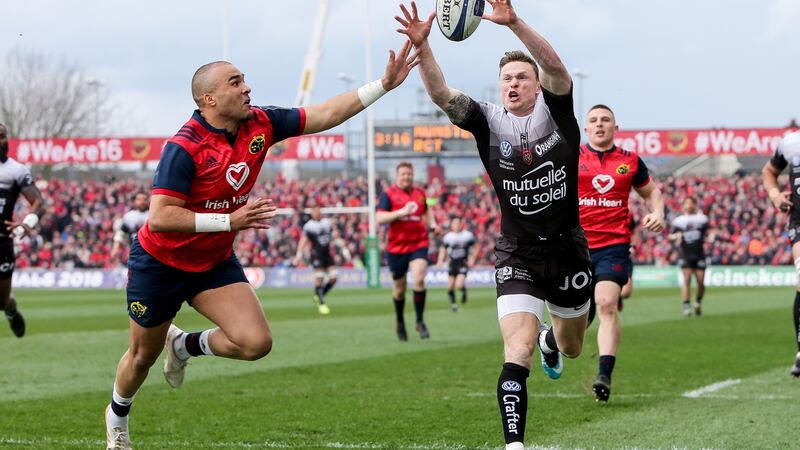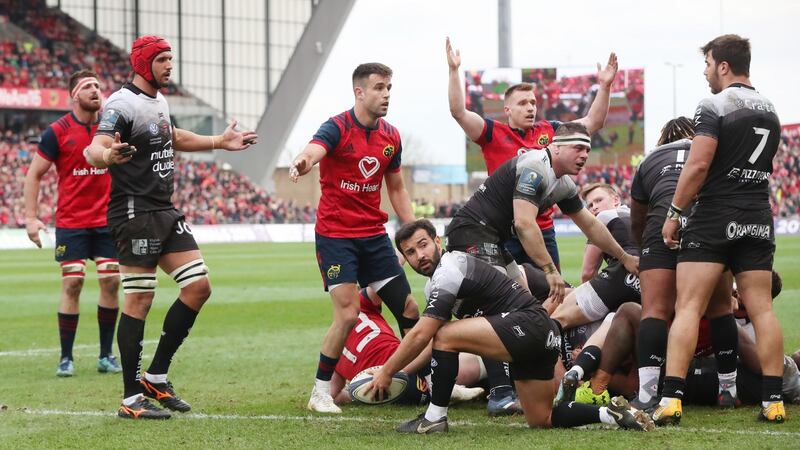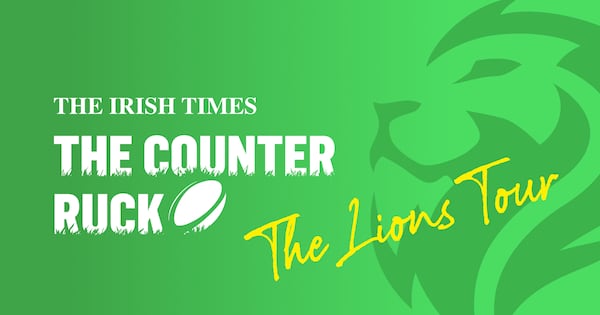To err is human, to forgive divine, and as in everything when humans are involved in making decisions, there’ll be erroneous ones.
All in all though, last weekend’s quarter-finals in the European Champions Cup did not portray rugby’s use of Television Match Officials and video replays in a particularly good light.
Such was their frequency and length in the Munster-Toulon match that the first half lasted 56 minutes, and with the second requiring 52 minutes, the game finished over two hours after it started. Not that too many in a capacity Thomond Park were complaining though.
Also, bearing in mind Luke Pearce’s performance in the Scarlets’ win over La Rochelle, it’s doubtful that the French teams felt particularly forgiving, even if one of them, Racing 92, were the beneficiaries of one rank bad decision despite recourse to the TMO, in their all-French quarter-final against Clermont.
Referrals to the Television Match Official and the use of video replays have been in existence since 2001, so rugby has long since moved on from the teething problems affecting the use of Video Assistant Referees in football. It’s still not perfect, but then again, it never will be.

When the protocol was first used in rugby, it was solely to determine the validity of tries, and was then expanded to take into account other incidents such as foul play. As Alain Rolland, World Rugby's 'High Performance 15s Match Officials' Manager, points out it is a very complex protocol, and the TMO now has a very specialised role within the team of four officials for any given match.
Even so, no less than referees, it’s clear that some TMOs are both more proactive and decisive, in other words better, than others.
“Yes, and I think everybody would agree with that,” says Rolland. “We’re always looking to improve how we would work, and the TMOs are striving to improve how they work with match officials, and that’s something we would do on an ongoing basis.”
Rolland highlights the example of the Six Nations, when they had workshops with all the match officials, including TMOs, every Wednesday.
“Overall, with the exception of one error in the Six Nations, the teams of match officials seemed to have worked reasonably well. There wasn’t a lot that was missed.”
“The TMO, in my view, should be used as a sweeper to help the team of three on the field, that when required they can assist, they can give information but the referee is the captain of the team. He’s the one that has to make the final decision, although it doesn’t necessarily always work that way.”
Wrong decision
Rolland says World Rugby hosts a couple of camps each year in which “we would simulate situations with TMOs and referees. We set up laptops and screens outside. They would be put through drills and then would look at clips and work with TMOs, and make decisions when they’re tired. We set up a number of clips and adjudicate how they do in their responses.
"We record them and we play them back. We’re continuously working behind the scenes to improve how we work together. Success is trying to get the decision right every time, and that’s what our objective is.”
With each passing year of professionalism, the stakes have heightened, especially for players and coaches. Hence, with referees under greater scrutiny perhaps, has come greater fear of making the wrong decision and so they are more inclined to take recourse to the TMO. Then, when using the protocol, referees and TMOs are then even more fearful of making an incorrect call.
“Paralysis by analysis,” as one former international referee puts it.
But, whatever about the Six Nations, weekly workshops are not practical in other competitions, such as the Premiership and Top 14, and particularly the Pro14 and the European Cups, with so many competing teams and officials from different countries.
“I agree 100 per cent and that’s one of the challenges that we have,” admits Rolland, “to create an environment where you can have your team in camp as much as possible to review and prepare for games, because the more you can do that as a group, the better chance you have of everybody being on the same page when it comes to making a decision.
“That said, it can’t be left to EPCR or to World Rugby to be the ones to continually drive this. Each Union has to take a responsibility to all have TMOs, and for training their own TMOs. In fairness, some Unions are doing it better than others.”

Another point worth stressing is that match officials are dependent upon the technology at their disposal. This is not the same for every competition, and won’t always be of the standard used in the Six Nations or World Cups, where the TMO will also be assisted by a technician.
“You won’t necessarily have the same system for each tournament or country, and I don’t think people realise that,” says Rolland. “TMOing is different in England and it’s different from TMOing in Ireland or TMOing in France, because the host broadcasters are the ones that drive the whole system.”
"When you look at the Rugby World Cup for example, we have a Hawkeye system which allows us the facility to have more control over what footage is being shown to the TMO at any one time. During the Six Nations there is an EVS Xeebra (multi camera review) system which allows a bit more control for the TMO to have the footage more quickly than if you're dealing in Europe or, say, the Pro14.
Hawkeye system
“For example, in some games, the TMO doesn’t even have a delayed screen. One of the things we have to strive to ensure is that the system is pretty much the same for every game, but that’s very difficult. To have the EVS or Hawkeye system is an additional cost for the stakeholders and isn’t always available.”
Rolland gives another example, without naming the country, from last November’s Test window.
“The TMO was working with a [broadcast] director who was [more used to] football, didn’t speak English, didn’t know what a ruck was, didn’t have a delayed screen and when the TMO went looking for footage, he wasn’t able to be get the footage. These are the challenges that TMOs sometimes have.”
“We also have some issues with [host] broadcasters who, when we want footage, they won’t show it, or they’ll show footage that we don’t want, because it’s drama to create a reaction, and that puts pressure on the match officials to start dealing with something that they don’t necessarily have to.
“We’ve had that in the past, where a TMO has looked for a particular angle and he hasn’t been able to get it, because it was against the home team. It doesn’t always happen, but it is a challenge every now and again, which is inhibiting the TMO from doing the best job he can.”
Mostly, the TMO is in an outside broadcasting van with the television director, most of whom are very efficient, understand rugby language and will have briefed the TMO as to all the different camera angles.
“But sometimes you can be unlucky, and have a director who is not as tuned in,” says Rolland, “and when you require something in a hurry you just can’t get it.”
Inevitably too, in a sport renowned for its respect for officials, they are being questioned more on the pitch, not least by defending teams after they’ve conceded a try. An unofficial appeals system has mushroomed.
Rolland counters by saying the TMOs will generally have a check list after a try is scored, in the knowledge that they have until the conversion to do so and can go back up to two phases, though no more. More often than not the referee will also have been inclined to check something regardless of player appeals.
Rolland speaks from on-field experience as well, having refereed from 1998 to 2014 following a playing career for Blackrock, Leinster and Ireland, for whom he won three caps. So he has experienced the game with and without TMOs.
Right outcomes
“If technology can help, then technology should be used, and in my view there’s probably a lot more decisions have been helped in coming to the right outcomes, than haven’t been. So it’s got to be doing something right.
“Yes, there have been mistakes. Yes, there have been head-scratching decisions where you just don’t get it, and that can just sometimes be down to either the TMO or the referee on the day seeing a certain picture that no-one else has seen. And that happens. You’re in a pressurised environment and the whole world is looking at you, and there are still some stadiums where it’s very difficult for a referee to actually see what’s going on, and that puts more pressure on the TMO because effectively he doesn’t have his team to work with.”
The use of video replays needs a number of ducks in a row for the system to work properly. The most important role remains that of the TMO, but he can only do his job effectively if he has all the tools possible for him to do so. Even with modern technology, not everything works perfectly all the time. Even in the Six Nations, the communications system can break down, meaning that when the TMO sought to relay information to the match officials, they couldn’t hear it.
Nonetheless, Rolland accepts that the six minutes and 40 seconds taken to award the Conor Murray try was excessive.
“Ideally we don’t want to stop the continuity or flow of a game, but you have to appreciate though that sometimes it can be very technical and difficult, and it can require a number of replays for the right decision. It shouldn’t take that long but we rarely have incidents that take that long, and that one was particularly complex.
“Unfortunately, it probably took too long but they got the right outcome, so if had taken six minutes and 40 seconds and got the decision wrong, we’d be having a different conversation. But the majority of the time, and I think people would agree, it is an asset that does work properly.”
In all of this, of course, one could take the view of Will Greenwood, that the repeated referrals and inordinate length of both the decision to award the Murray try and that first half in Thomond Park added to the drama.
At least the 26,265 crowd, though frustrated by the excessive amount of replays, could watch it unfold, whereas football crowds are kept in the dark when the VAR system is used and thus haven’t a clue what’s going on. Similarly, those watching the Thomond Park quarter-final at home can also hear the conversations between referee and TMO.
Ultimately too, the use of TMOs and video replays has ensured many more correct decisions than wrong ones. Better to take six minutes and 40 seconds to get it right, than shorter to get it wrong.
Revisiting TMO controversies
Clermont v Racing 92
Marc Andreu try
Referee Wayne Barnes and his TMO Rowan Kitt from England permitted a try by Marc Andreu despite the final pass by Dan Carter clearly being forward. Video replays showed that the ball travelled forward on leaving Carter's hands and continuing on that trajectory. Coming in the 63rd minute, Clermont were leading 17-16 at the time, and lost 28-17.
Against that, Kitt suspected that Camille Chat had blocked a Racing player before Virimi Vakatawa touched down in the 23rd minute, prompting Barnes to have a look at replays before Morgan Parra took the conversion, and on review Barnes correctly disallowed a Clermont try.
Leinster v Saracens
Richard Wigglesworth high, late hit on Johnny Sexton
The Saracens scrumhalf was penalised, but as he jumped off the ground and led with his right shoulder into Sexton's head, by rights the TMO Philippe Bonhoure should have advised referee Jerome Garces to have another look at it, which would have led to a yellow card for Wigglesworth. Above all else, match officials have a duty of care to players.
Munster v Toulon
Simon Zebo denies Chris Ashton a try
In the very first minute at Thomond Park, Zebo prevented Ashton from gathering Eric Escande's kick into the in-goal area when palming the ball one-handed over touch-in-goal. Admittedly, it was the first of two very complicated decisions for Nigel Owens and his match officials, with Ashton and Zebo colliding, and even Scott Quinnell, who thought it should have been a yellow card, and Will Greenwood, who thought Zebo was endeavouring to gather the ball one-handed, disagreed completely. On balance, Zebo and Munster got away with that one.
Munster v Toulon
Conor Murray try
When Owens and his TMO deliberated over the Murray try, the Welsh referee asked Jon Mason to check three things, namely whether Andrew Conway had knocked on, whether Guilhem Guirado had knocked on at the base of a ruck and whether Murray was onside.
They took an age over the second query, although in point of fact it was ultimately irrelevant, as once Guirado played the ball that meant the ruck was over. From the moment Owens signalled the use of video replays to the moment he confirmed his decision took six minutes and 40 seconds. That said, it’s worth noting that at least they came to the right decision, which is the point of the exercise.
Toulon having been on the wrong end of the two most contentious decisions, as well as for the late shove by Semi Radrada on Darren Sweetnam on the half-hour which led to a penalty by Ian Keatley, it may explain why Owens was reluctant to adjudge the Francois Trinh-Duc offload to Mathieu Bastareaud was forward, even though it appeared to be, while Munster could also feel aggrieved by him wrongfully decreeing that Sweetnam tapped the ball forward in the build-up to Alex Wootton being sent clear.













